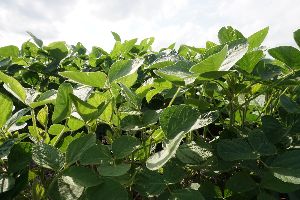What Are the Benefits of Soybean Seed Treatments?

In their earliest development stages, soybeans are vulnerable to outside influences that can impair their growth and lead to lower yields. There are agronomy methods, however, to protect nascent seedlings and allow them to thrive. Many farmers rely on seed treatments for their capacity to defend seedlings from insects and disease and their ability to stimulate root growth and provide more micro-nutrients. Consult the guide below for more information on how your crops can benefit from treatments.
How Do Seed Treatments Protect Soybean Plants?
Prevent Diseases
All agronomy plans contain strategies for preventing or stopping the spread of plant-killing diseases. Fields prone to Sudden Death Syndrome (SDS), phytophthora, or white mold benefit from using a fungicide treatment by Tripidity® with Heads Up®. It uses systemic acquired resistance (SAR) to activate the plant's own genetic resistance to diseases by stimulating its natural defense pathways before disease sets in. This treatment provides full-season protection against yield-robbing pathogens. Tripidity is a unique seed protection technique that contains essential nutrients and biostimulant additives, which can maximize early seedling vigor and crop development to increase yield potential. Many current soybean fungicide treatments also remove nematodes, which are an increasingly common threat to Wisconsin crops.
Minimize Insects
Insects infest the land, and through their feeding, weaken vulnerable plants at their earliest developmental stages. By the time the stress becomes noticeable, the crops usually can't be saved. Farmers may have to replant to offset the diminished yield, but the insects are just as likely to start feeding on the new crops, as well. An insecticide can provide lasting protection and help seedlings increase their vigor and emerge in uniform patterns.
What Fields Benefit From Seed Treatments?

Soybean treatments have fungicide and insecticide variants and combinations to provide comprehensive protection against diseases and insects. All fields can benefit from these products, especially if the land has certain qualities.
Cold and wet soil can provide an optimal location for mold and diseases to thrive while also stymieing germination and emergence. Treatments can reduce or prevent diseases and offer agricultural biostimulants to hasten a stronger product in a shorter period.
In turn, insects are also an issue. Fields with a large amount of leftover trash can become home to insects over the winter, while others experience early-season infestations. Consulting with an agronomy advisor on the best treatment variant for your land will help ensure a smoother growing season.
For over 100 years, the agronomy advisors at Allied Cooperative® have helped farmers increase soybean yields with the proper equipment and protect them with seed treatments. Their operations began in Adams, WI, and they have expanded to 10 other locations to ensure their clients have the tools and supplies they need all year long. The cooperative's advisors are also always available to generate customized yield data and tech sheets on their soybean treatments, so you can see the tangible benefits of using their products. For more information on their services, visit their website or call them at (800) 247-5679.
About the Business
Have a question? Ask the experts!
Send your question

